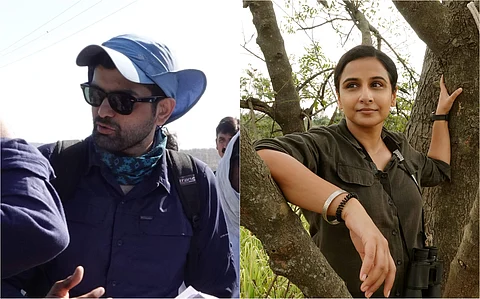

It’s a few days after the release of Sherni, and I’m probing director Amit Masurkar on the thread of idealism in his movies. The question seems inevitable – after all, his last feature, Newton (2017), also dealt with that. “I think it’s just coincidence,” Amit says, more eager to point up the differences between the two films. The character of Newton, he explains, was modelled on Don Quixote, possessed of a similar bookish adventurism. By contrast, Sherni’s Vidya Vincent – a female forest officer played by Vidya Balan – has her feet on the ground. “The characters in Sherni are not allegorical,” Amit says. “Its scope is much larger and wider.”
We spoke to Amit about the film’s thrilled reception, writing and researching on conservation, creating CGI animals and casting Sharat Saxena as a bull-headed hunter…
Sherni has been received warmly by all quarters…
It’s been a good two weeks for everyone involved with the film. I’m happy that people are liking it. A lot of subject experts have been writing to us, putting up posts on social media. It was a delicate topic to portray and we were worried about doing justice to it. When people who are working in the field give you their nod, it means a lot.
Take us through the writing and researching process of the film.
Screenwriter Aastha Tiku and I were talking about doing a film on conservation. The story kept changing because it was such a vast subject. But the basic philosophy of it was that conservation is not a hero-driven process. You need the whole community in a sustained effort to preserve the ecosystem. We chose the tiger because it’s a flagship species for conservation. If we save the tiger, we end up saving the entire ecosystem.
Moreover, Aastha comes from a strong research background of education, philosophy and psychology. We had a great research associate named Siddesh Kankekar who helped us. We also consulted several experts including Dr Ramzan Virani, who is a conservationist and wildlife researcher.
Your debut film, Sulemani Keeda, was a comedy set in Mumbai. Since then, you have retreated to the jungles of Chhattisgarh (Newton) and Madhya Pradesh (Sherni). What prompted this artistic migration in you?
It’s been an organic process, really. Between Newton and Sherni, there were several other ideas I was exploring. I don’t think I am planning anything.
So another comedy might happen as easily?
Anything can happen.
In Sherni, Vidya is told that the teak plantations ordered by the government have shut the grazers out, making them vulnerable to tiger attacks. It’s an interesting detail because it shows how forest management isn’t so linear…
This was something that came up during the research. The truth is, if you destroy a forest it’s gone. It won’t be back just by planting an equal number of trees somewhere else. You can’t replace a natural forest that has been there for hundreds of years.
The film gets satirical in its depiction of the forest department and bureaucracy. Were they on board with all of this?
We have actually portrayed the forest department in a positive light. We have highlighted the hard work many of them do, from daily wagers to guards to RFOs. Even the characters who have a bit of grey in them are not bad. For instance, Neeraj Kabi’s character, Nangia, has done a lot of good work. We had the full support of the Madhya Pradesh forest department. They let us shoot in their offices and bungalows (Vidya’s house). A lot of forest officers have acted in the film as well.
I found the casting of Sharat Saxena as the hunter quite intriguing…
Sharat lives a couple of buildings away from me. All of us have grown up watching him on the big screen. He has this amazing personality. So when the hunter’s character came up, he was the first choice. In fact, right after we approached Vidya, we approached Sharat for the role. He connected with it because he is from Madhya Pradesh. He is familiar with the jungles and that world.
You created the animals, including the tigress and her cubs, in VFX. It’s stunning work.
It would have been much easier and cheaper to go to Thailand and shoot with real tigers. They drug and exploit those animals and that’s not something we were comfortable with. For the film, the tigers and the dead buffalo were done by a VFX company called Cirqus. They are a Hyderabad-based company whose founders worked on Life of Pi (2012). And the bear was done by another company called FutureWorks.
In India, a lot of international VFX work happens but you have to give the artists time. We had a decent VFX budget because the animals were characters in the film. It was non-negotiable.
All right, where are you headed next– Ranthambore, Jim Corbett, Gir, Kaziranga, or the Sunderbans?
You mean for vacation or shooting?
Both?
Shooting I don’t know yet. As for vacation, I’ve never been to Assam. It will be an interesting place to visit.